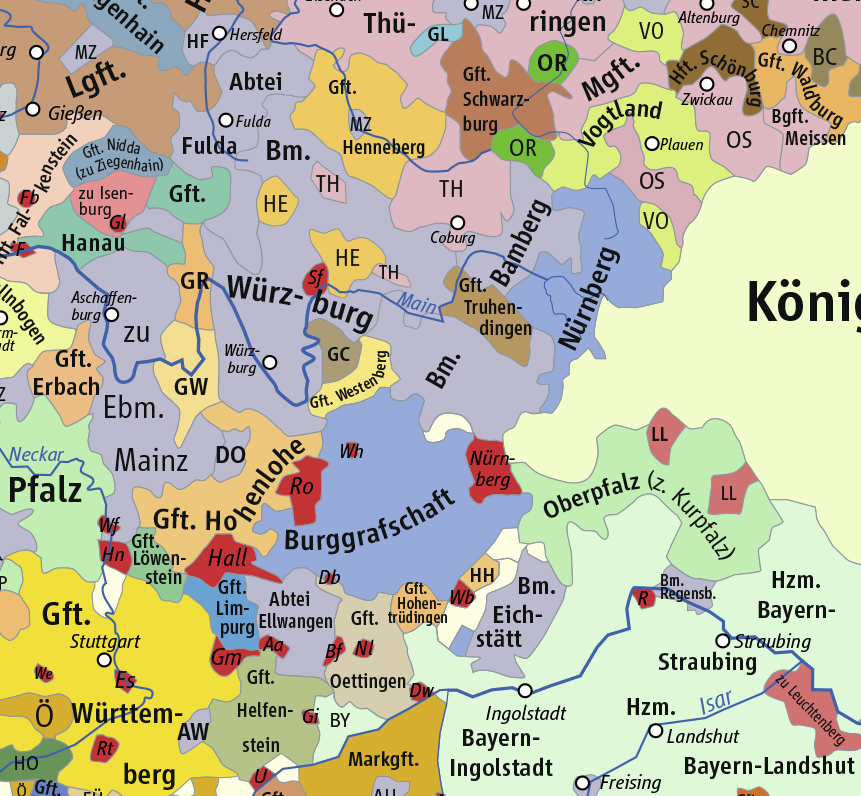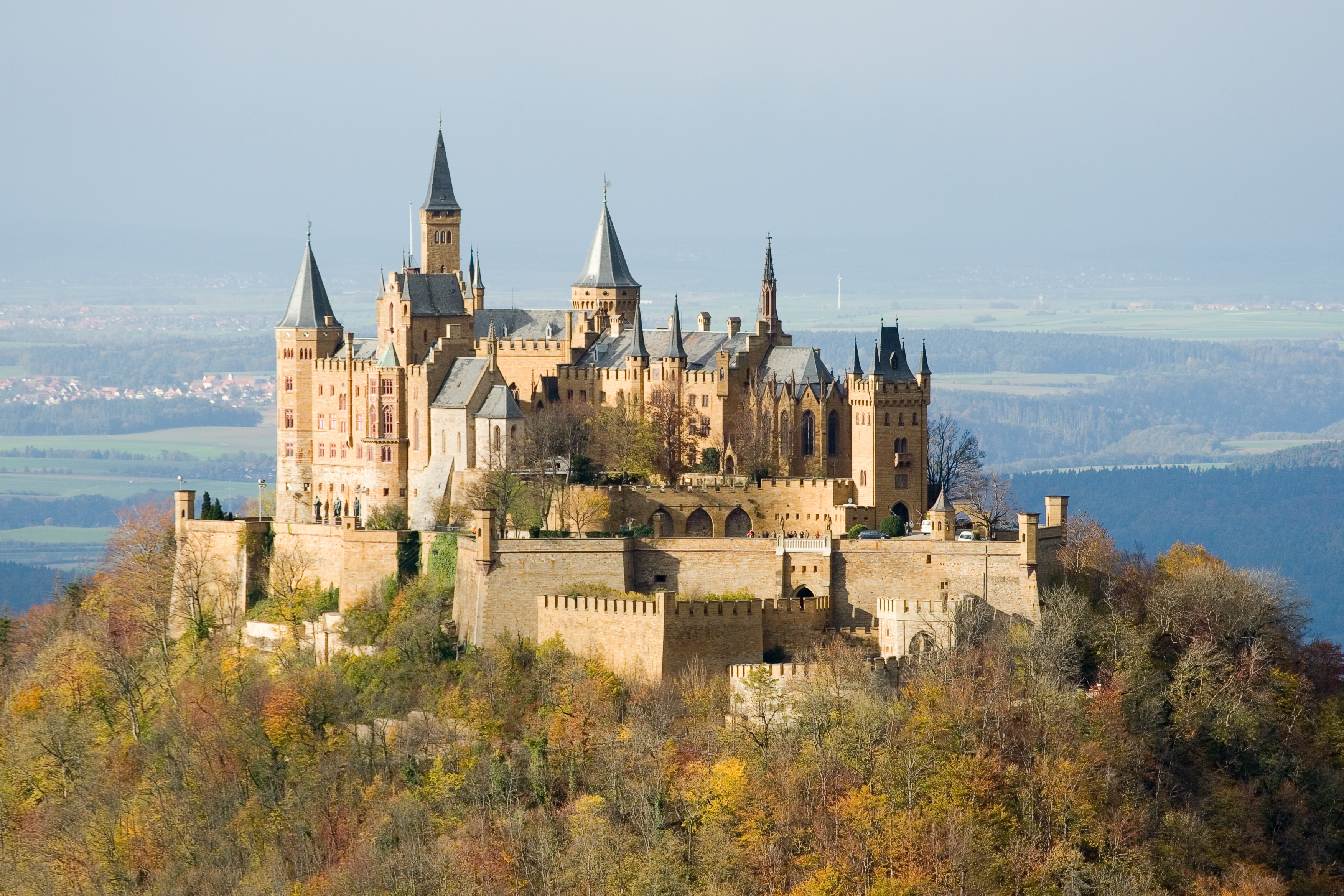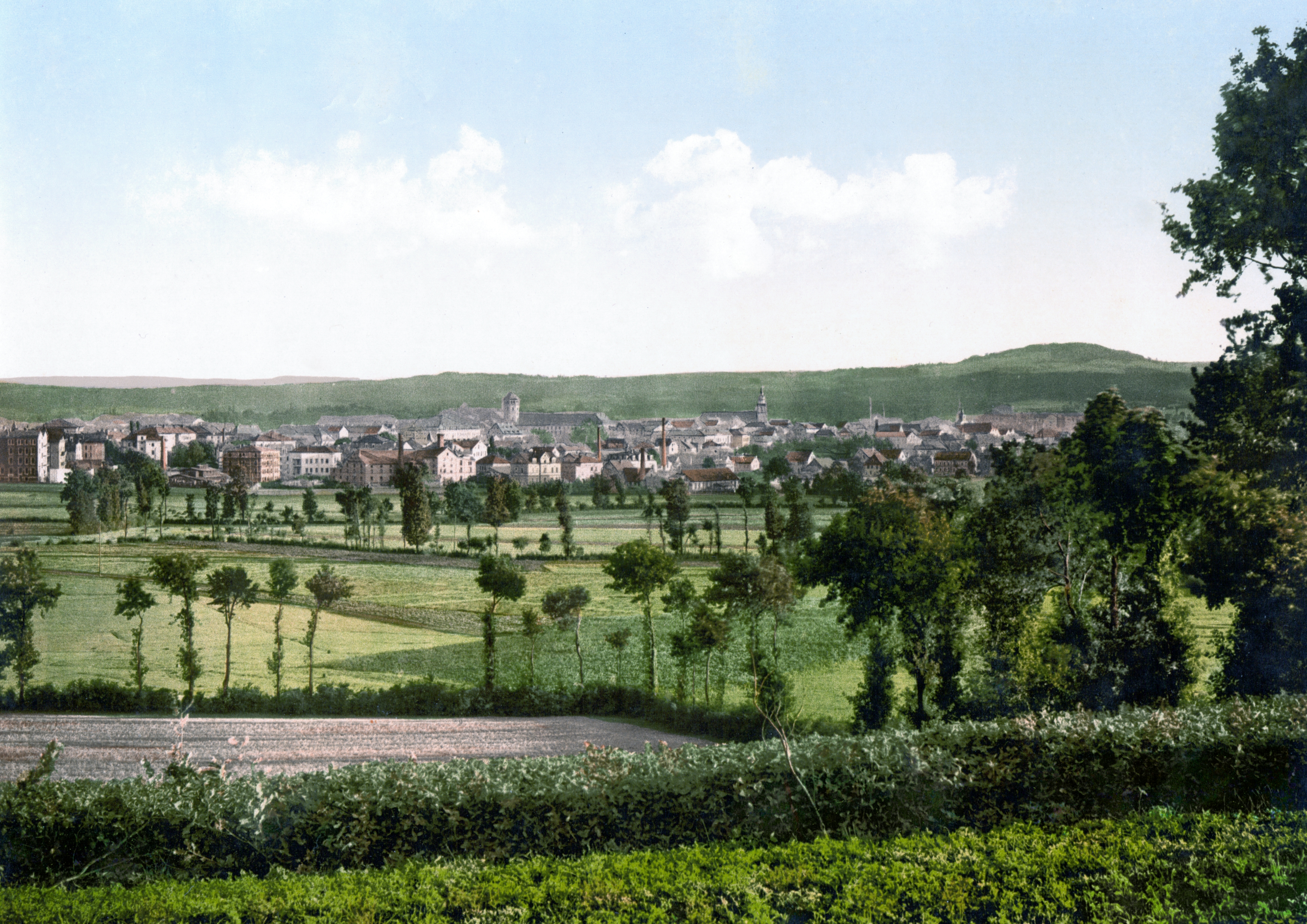|
Ordre De La Sincérité
The Ordre de la Sincérité (), was an order of knighthood of the German Margrave of Bayreuth. The order's name came from 18th-century courtiers who spoke French. The order had fifty knights. It was later renamed the Order of the Brandenburg Red Eagle and later as the Order of the Red Eagle. History The Ordre de la Sincérité was founded on November 17, 1705, by the ruling Margrave George William of Brandenburg-Bayreuth, a member of the House of Hohenzollern. As it was often the case with the orders of knighthood of the small German courts it soon fell into disuse. However, was revived in 1712 in Brandenburg-Bayreuth and again in 1734 in Brandenburg-Ansbach, where it was renamed "Order of the Brandenburg Red Eagle". The statutes were changed in 1777 and the order named therein as the "Order of the Red Eagle". The order was conferred in one class, limited to fifty knights. The church of the order was the Ordenskirche St. Georgen in Bayreuth. In January 1792, the Kingdom of Prussi ... [...More Info...] [...Related Items...] OR: [Wikipedia] [Google] [Baidu] |
George William, Margrave Of Brandenburg-Bayreuth
George William of Brandenburg-Bayreuth (German: ''Georg Wilhelm''; 16 November 1678 in Bayreuth – 18 December 1726 in Bayreuth) was a member of the House of Hohenzollern and Margrave of Brandenburg-Bayreuth. Family He was the first son of Christian Ernst, Margrave of Brandenburg-Bayreuth by his second wife, Sophie Louise of Württemberg-Stuttgart, the fifth of six children. Two sisters died in infancy before his own birth, and his only brother, born in 1679, lived only five months. Of his two surviving sisters, the eldest, Christiane Eberhardine, became the wife of August II the Strong, Elector of Saxony and King of Poland, and the youngest, Eleonore Magdalene, married a distant kinsman, Hermann Frederick, Count of Hohenzollern-Hechingen. Life George William succeeded his father as margrave of Bayreuth when he died on 20 May 1712. He pursued a military career due to a lack of academic aptitude and participated successfully on the imperial side in numerous battles. In th ... [...More Info...] [...Related Items...] OR: [Wikipedia] [Google] [Baidu] |
Chivalric Order
An order of chivalry, order of knighthood, chivalric order, or equestrian order is a society, fellowship and college of knights, typically founded during or inspired by the original Catholic military orders of the Crusades ( 1099–1291) and paired with medieval concepts of ideals of chivalry. Since the 15th century, orders of chivalry, often as dynastic orders, began to be established in a more courtly fashion than could be created ''ad hoc''. These orders would often retain the notion of being a confraternity, society or other association of members, but some of them were ultimately purely honorific and consisted of a medal decoration. In fact, these decorations themselves often came to be known informally as '' orders''. These institutions in turn gave rise to the modern-day orders of merit of sovereign states. Overview An order of knights is a community of knights composed by order rules with the main purpose of an ideal or charitable task. The original ideal lay in monach ... [...More Info...] [...Related Items...] OR: [Wikipedia] [Google] [Baidu] |
Order Of The Black Eagle - Ribbon Bar
Order, ORDER or Orders may refer to: * A socio-political or established or existing order, e.g. World order, Ancien Regime, Pax Britannica * Categorization, the process in which ideas and objects are recognized, differentiated, and understood * Heterarchy, a system of organization wherein the elements have the potential to be ranked a number of different ways * Hierarchy, an arrangement of items that are represented as being "above", "below", or "at the same level as" one another * an action or inaction that must be obeyed, mandated by someone in authority People * Orders (surname) Arts, entertainment, and media * ''Order'' (film), a 2005 Russian film * ''Order'' (album), a 2009 album by Maroon * "Order", a 2016 song from '' Brand New Maid'' by Band-Maid * ''Orders'' (1974 film), a film by Michel Brault * "Orders" (''Star Wars: The Clone Wars'') Business * Blanket order, a purchase order to allow multiple delivery dates over a period of time * Money order or postal order, a ... [...More Info...] [...Related Items...] OR: [Wikipedia] [Google] [Baidu] |
Principality Of Bayreuth
The Principality of Bayreuth () or Margraviate of Brandenburg-Bayreuth (''Markgraftum Brandenburg-Bayreuth'') was an immediate territory of the Holy Roman Empire, ruled by a Franconian branch of the Hohenzollern dynasty. Since Burgrave Frederick VI of Nuremberg was enfeoffed with the Margraviate of Brandenburg in 1415/17, the Hohenzollern princes transferred the margravial title to their Franconian possessions, though the principality never had been a march. Until 1604 they used Plassenburg Castle in Kulmbach as their residence, hence their territory was officially called the Principality of Kulmbach or Margraviate of Brandenburg-Kulmbach until the Empire's dissolution in 1806. Geography The Kulmbach-Bayreuth principality arose from the northern uplands (''Oberland'') of the former Burgraviate of Nuremberg, while the southern lowlands (''Unterland'') formed the Principality of Ansbach. The final border demarcation was settled by the 1541 House Treaty of Regensburg, addin ... [...More Info...] [...Related Items...] OR: [Wikipedia] [Google] [Baidu] |
Order Of The Red Eagle
The Order of the Red Eagle () was an order of chivalry of the Kingdom of Prussia. It was awarded to both military personnel and civilians, to recognize valor in combat, excellence in military leadership, long and faithful service to the kingdom, or other achievements. As with most German and other European orders, the Order of the Red Eagle could be awarded only to commissioned officers or civilians of approximately equivalent status. However, there was a medal of the order, which could be awarded to non-commissioned officers and enlisted men, lower ranking civil servants and other civilians. History The predecessor to the Order of the Red Eagle was founded on 17 November 1705, by the Margrave Georg Wilhelm of Brandenburg-Bayreuth as the '' Ordre de la Sincérité''. This soon fell into disuse but was revived in 1712 in Brandenburg-Bayreuth and again in 1734 in Brandenburg-Ansbach, where it first received the name of "Order of the Brandenburg Red Eagle". The statutes were change ... [...More Info...] [...Related Items...] OR: [Wikipedia] [Google] [Baidu] |
House Of Hohenzollern
The House of Hohenzollern (, ; , ; ) is a formerly royal (and from 1871 to 1918, imperial) German dynasty whose members were variously princes, Prince-elector, electors, kings and emperors of Hohenzollern Castle, Hohenzollern, Margraviate of Brandenburg, Brandenburg, Prussia, the German Empire, and Kingdom of Romania, Romania. The family came from the area around the town of Hechingen in Swabia during the late 11th century and took their name from Hohenzollern Castle. The first ancestors of the Hohenzollerns were mentioned in 1061. The Hohenzollern family split into two branches, the Catholic Church, Catholic Swabian branch and the Protestantism, Protestant Burgraviate of Nuremberg#List of burgraves, Franconian branch,''Genealogisches Handbuch des Adels, Fürstliche Häuser'' XIX. "Haus Hohenzollern". C.A. Starke Verlag, 2011, pp. 30–33. . which ruled the Burgraviate of Nuremberg and later became the Brandenburg-Prussian branch. The Swabian branch ruled the principalities of Hoh ... [...More Info...] [...Related Items...] OR: [Wikipedia] [Google] [Baidu] |
Bayreuth
Bayreuth ( or ; High Franconian German, Upper Franconian: Bareid, ) is a Town#Germany, town in northern Bavaria, Germany, on the Red Main river in a valley between the Franconian Jura and the Fichtel Mountains. The town's roots date back to 1194. In the 21st century, it is the capital of Upper Franconia and has a population of 72,148 (2015). It hosts the annual Bayreuth Festival, at which performances of operas by the 19th-century German composer Richard Wagner are presented. History Middle Ages and Early Modern Period The town is believed to have been founded by the counts of County of Andechs, Andechs probably around the mid-12th century,Mayer, Bernd and Rückel, Gert (2009). ''Bayreuth – Tours on Foot'', Heinrichs-Verlag, Bamberg, p.5, . but was first mentioned in 1194 as ''Baierrute'' in a document by Bishop Otto VI of Andechs, Otto II of Bishopric of Bamberg, Bamberg. The syllable ''-rute'' may mean ''Rodung'' or "clearing", whilst ''Baier-'' indicates immigrants from ... [...More Info...] [...Related Items...] OR: [Wikipedia] [Google] [Baidu] |
Kingdom Of Prussia
The Kingdom of Prussia (, ) was a German state that existed from 1701 to 1918.Marriott, J. A. R., and Charles Grant Robertson. ''The Evolution of Prussia, the Making of an Empire''. Rev. ed. Oxford: Clarendon Press, 1946. It played a significant role in the unification of Germany in 1871 and was a major constituent of the German Empire until its German Revolution of 1918–1919, dissolution in 1918. Although it took its name from the Prussia (region), region called Prussia, it was based in the Margraviate of Brandenburg. Its capital was Berlin. The list of monarchs of Prussia, kings of Prussia were from the House of Hohenzollern. The polity of Brandenburg-Prussia, predecessor of the kingdom, became a military power under Frederick William, Elector of Brandenburg, known as "The Great Elector". As a kingdom, Prussia continued its rise to power, especially during the reign of Frederick the Great, Frederick II "the Great".Horn, D. B. "The Youth of Frederick the Great 1712–30." ... [...More Info...] [...Related Items...] OR: [Wikipedia] [Google] [Baidu] |
Frederick William II Of Prussia
Frederick William II (; 25 September 1744 – 16 November 1797) was King of Prussia from 1786 until his death in 1797. He was also the prince-elector of Brandenburg and (through the Orange-Nassau inheritance of his grandfather) sovereign prince of the Canton of Neuchâtel. As a defensive reaction to the French Revolution, Frederick William II ended the German Dualism between Prussia and Austria. Domestically, he turned away from the enlightened style of government of his predecessor and introduced a tightened system of censorship and religious control. The king was an important patron of the arts especially in the field of music. As a skilled cellist he enjoyed the dedication of various cellocentric compositions by composers Mozart, Haydn, Boccherini, and Beethoven. He was also responsible for some of the most notable architecture in Prussia, including the Brandenburg Gate in Berlin, the Marble Palace, and Orangery in the New Garden, Potsdam. Early life Frederick Willia ... [...More Info...] [...Related Items...] OR: [Wikipedia] [Google] [Baidu] |
Order Of The Black Eagle
The Order of the Black Eagle () was the highest order of chivalry in the Kingdom of Prussia. The order was founded on 17 January 1701 by Elector Friedrich III of Brandenburg (who became Friedrich I of Prussia, Friedrich I, King in Prussia, the following day). In his Dutch exile after World War I, deposed Emperor Wilhelm II of Germany, Wilhelm II continued to award the order to his family. He made his second wife, Hermine Reuss of Greiz, Princess Hermine Reuss of Greiz, a Lady in the Order of the Black Eagle. Overview The statutes of the order were published on 18 January 1701, and revised in 1847. Membership in the Order of the Black Eagle was limited to a small number of knights, and was divided into two classes: members of reigning houses (further divided into members of the House of Hohenzollern and members of other houses, both German and foreign) and capitular knights. Before 1847, membership was limited to nobles, but after that date, capitular knights who were not noble ... [...More Info...] [...Related Items...] OR: [Wikipedia] [Google] [Baidu] |
Maximilian Gritzner
Adolf Maximilian Ferdinand Gritzner (29 July 1843 – 10 July 1902) was a German expert on heraldry and a herald in the Ministry of the Interior in Berlin. His reference book on orders of knighthood was still in print in 2000. Gritzner was born in Sorau (Żary) and died in Berlin. According to Bruno Bernard Heim, Gritzner "coined the definitive terms of the German heraldry". In 1893 Gritzner published his authoritative book on faleristics and as a herald in the Prussia Prussia (; ; Old Prussian: ''Prūsija'') was a Germans, German state centred on the North European Plain that originated from the 1525 secularization of the Prussia (region), Prussian part of the State of the Teutonic Order. For centuries, ...n Home-Office he was involved in exposing several phoney noblemen. Gritzner was "Königlich Preussischer Kanzleirat und Premierleutnant ausser Dienst" (German for " Royal council to the Chancellery and First Lieutenant on leave"). Gritzner's son, Dr. Erich Grit ... [...More Info...] [...Related Items...] OR: [Wikipedia] [Google] [Baidu] |






